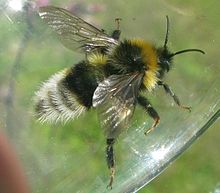Bombus bohemicus
| Bombus bohemicus | |
|---|---|
 |
|
| Female | |
 |
|
| Male | |
| Scientific classification | |
| Kingdom: | Animalia |
| Phylum: | Arthropoda |
| Class: | Insecta |
| Order: | Hymenoptera |
| Family: | Apidae |
| Genus: | Bombus |
| Subgenus: | (Psithyrus) |
| Species: | B. bohemicus |
| Binomial name | |
|
Bombus bohemicus Seidl, 1838 |
|
| Synonyms | |
|
|
Bombus bohemicus, also known as the gypsy's cuckoo bumblebee, is a species of socially parasitic cuckoo bumblebee found in most of Europe and the United Kingdom with the exception of the southern Iberian Peninsula and Iceland.B. bohemicus practices inquilinism, or brood parasitism, of other bumblebee species. B. bohemicus is a generalist parasite, successfully invading several species from genus Bombus. The invading queen mimics the host nest's chemical signals, allowing her to assume a reproductively dominant role as well as manipulation of host worker fertility and behavior.
B. bohemicus is part of the order Hymenoptera, which includes ants, bees, wasps, and sawflies, the family Apidae, specific to bees, and the genus Bombus, which includes all bumblebees. B. bohemicus belongs to the subgenus Psithyrus, or the Cuckoo bees, which includes 29 species found in Europe and the New World. Species in this subgenus are obligate parasites, meaning that they can no longer successfully reproduce or even survive long independently of their hosts, because the females have lost their pollen-collecting corbiculae and their ability to rear their own brood. Cuckoo bees have also entirely eliminated the worker class, producing only reproductive males and females. This form of parasitism is known as inquilinism.
Psithyrus was historically considered a separate genus from Bombus due to the significant biological and morphological differences associated with its parasitic life cycle. However, the majority of phylogenetic research in the last few decades has supported the recent conclusion that Psithyrus is a monophyletic group within Bombus. Morphology and phylogenetic analysis supports a close relationship with Bombus ashtoni from North America, suggesting a recent speciation event, or even that these bee species actually represent geographically separated populations of the same species. In Europe, they are often confused with Bombus vestalis, since both are parasitic and are found in the same region. B. bohemicus can hence be identified by its more intense colors and the fact that it is a generalist when choosing its host.
...
Wikipedia
